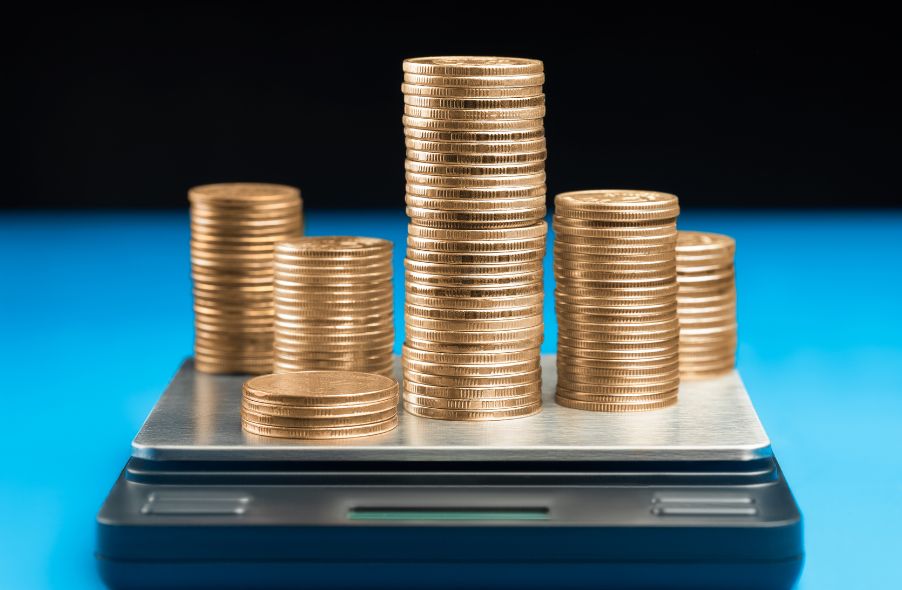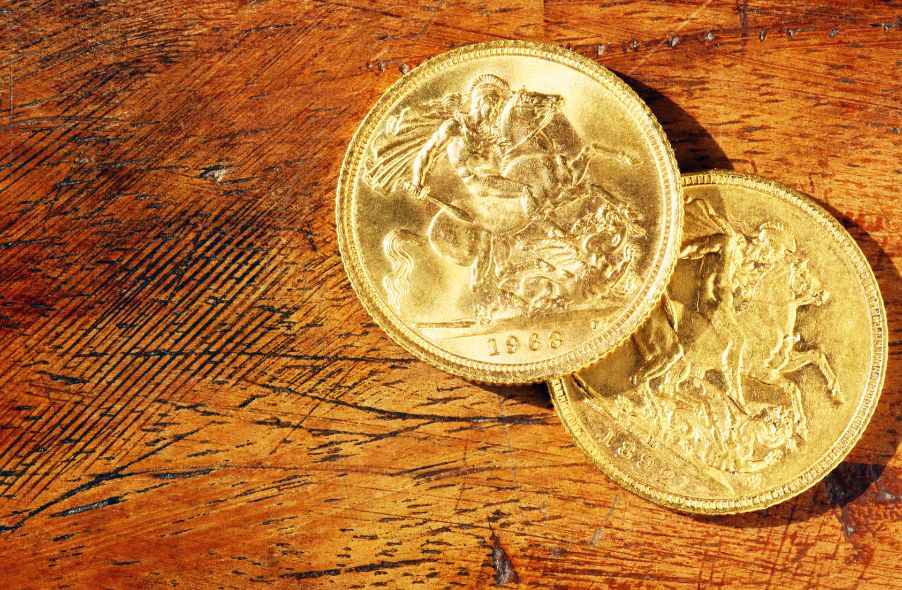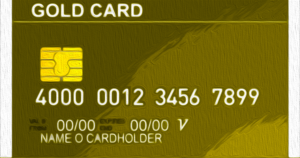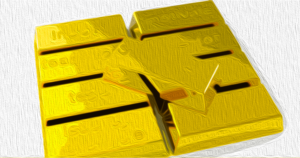
Investing in gold offers a unique opportunity to choose from a variety of gold coins to add to your collection. Among these coins, gold sovereigns have a fascinating history that attracts many investors. But what exactly is a gold sovereign, and is it a worthy investment?
Understanding Gold Sovereigns
A gold sovereign is a gold coin that was issued by the British Royal Mint. These coins were once used as British currency, each with a face value of £1. While they are no longer in circulation, gold sovereign coins remain popular among investors and collectors.
Due to their gold content of approximately 0.2354 troy ounces, gold sovereigns hold inherent value in addition to their numismatic worth. This makes them highly liquid and sought after by investors who want to diversify their portfolios with safe and stable assets.
Exploring Gold Proof Sovereigns
Gold proof sovereigns are a specific type of gold sovereign coins. These coins feature a hand-polished, high-quality finish that gives them a mirror-like appearance. Some investors are willing to pay a premium for these coins due to their unique aesthetics.
History and Popularity of Gold Sovereigns
Gold sovereign coins date back to 1489, during the reign of Henry VII. The first gold sovereign depicted the king's portrait on the front and featured a double rose on the reverse, symbolizing the union between York and Lancaster.
Over the years, subsequent monarchs introduced new versions of the gold sovereign with their own portraits. In 1815, after the Battle of Waterloo, a new 20-shilling coin was created, bearing the image of St. George and the dragon. In 1817, the gold sovereign became an official circulating coin in Britain and other parts of the world.
Throughout history, the design of gold sovereigns has evolved to reflect significant periods, such as Queen Victoria's reign. In 1914, the British government ceased circulating gold sovereigns due to a surge in gold buyers. Since then, the Royal Mint has produced gold sovereigns specifically for the bullion market, featuring designs of Queen Elizabeth and King Charles III.
Design and Minting of Gold Sovereigns
While the Royal Mint is the primary manufacturer of gold sovereigns, other mints in countries like Canada, South Africa, and Australia have also produced these coins. The quality and standards of gold sovereigns minted in other countries are comparable to those minted in the U.K.

Throughout its history, the gold sovereign coin has featured various designs. However, one prominent designer, Benedetto Pistrucci, stands out for his well-known reverse image of St. George and the dragon. This design has been a consistent feature on gold sovereigns since Queen Victoria's era and later appeared on the half-sovereign coin.
Gold Content and Weight of Sovereign Coins
The gold content and weight of sovereign coins have varied over time. Currently, the standard gold content is 7.323 grams, equivalent to 0.2354 troy ounces. The purity of these coins is 0.9167, with the remaining 1/12 consisting of copper.
Historical versions of gold sovereigns had different weights and gold contents. For instance, Henry VII's first version contained 0.5 troy ounces and weighed 15.55 grams.
In the mid-19th century, authorities discovered that sovereign coins were becoming lighter due to the softness of gold. The weight of sovereigns at the time was intended to be 123.274 grains or nearly eight grams. Coins weighing less than 122.5 grains were deemed no longer legal tender.
Taxation and Exemptions for Gold Sovereigns
Residents of the U.K. benefit from tax exemptions when selling gold sovereign coins. These coins are not subject to capital gains taxes, allowing sellers to retain 100% of their profits. The same tax exemption applies to any gold coins produced by the Royal Mint as legal tender, regardless of the sales volume or value.
Investing in gold sovereigns can be highly lucrative for individuals residing in the U.K., especially when compared to other gold investments. For reference, the typical capital gains tax rate on gold is 28%. Residents of the United States may also have the advantage of purchasing gold sovereign coins without paying sales tax, as policies on taxing coins and precious metal bullion vary by state.
Investment and Diversification with Gold Sovereigns
Adding gold sovereign coins to your investment portfolio is an exciting way to diversify your holdings. Gold itself is a reliable hedge against inflation, as its value tends to rise when the value of the dollar declines. Moreover, gold is a highly liquid asset and can be sold through various online and in-person methods.
Investing in gold sovereigns, which have collectible value beyond their gold content, can amplify their worth. Collectors are willing to pay a premium for these coins simply to add them to their collections. When you decide to sell, finding an interested buyer should not be a challenge.

Determining the Value of a Gold Sovereign
The base value of a gold sovereign coin can be calculated by multiplying its weight in troy ounces by the spot price of gold. The spot price varies daily, but in 2023, it is expected to average around $1,844 per troy ounce. With a standard weight of 0.2354 troy ounces, the average value of one gold sovereign coin would be approximately $434.
Older and rarer gold sovereign coins may fetch higher prices than newer varieties. To accurately assess the value of a specific gold sovereign coin, it's advisable to study the prices of similar coins sold by other sellers. Thorough research will allow you to determine the appropriate value for your investments, whether you are considering a purchase, sale, or simply expanding your knowledge.
Conclusion
Now that you have a comprehensive understanding of what a gold sovereign coin is, you can make an informed decision about whether it fits into your investment portfolio. For further information on investing in physical gold or a gold IRA, feel free to explore the Learn About Gold blog.
Frequently Asked Questions
How much tax is gold subject to in an IRA
The fair market value at the time of sale is what determines how much tax you pay on gold sales. Gold is not subject to tax when it's purchased. It isn't considered income. If you decide to sell it later, there will be a taxable gain if its price rises.
As collateral for loans, gold is possible. Lenders try to maximize the return on loans that you take against your assets. This usually involves selling your gold. This is not always possible. They might just hold onto it. They may decide to resell it. The bottom line is that you could lose potential profit in any case.
To avoid losing money, only lend against gold if you intend to use it for collateral. You should leave it alone if you don't intend to lend against it.
How to Open a Precious Metal IRA
The first step in opening an Individual Retirement Account, (IRA), is to decide if it's something you want. Once you have decided to open an Individual Retirement Account (IRA), you will need to complete Form 806. For you to determine the type and eligibility for which IRA, you need Form 5204. This form should be filled within 60 calendar days of opening the account. Once this has been completed, you can begin investing. You could also opt to make a contribution directly from your paycheck by using payroll deduction.
If you opt for a Roth IRA, you must complete Form 8903. Otherwise, the process is identical to an ordinary IRA.
To qualify for a precious-metals IRA, you'll need to meet some requirements. The IRS stipulates that you must have earned income and be at least 18-years old. Your annual earnings cannot exceed $110,000 ($220,000 if you are married and file jointly) for any tax year. Contributions must be made on a regular basis. These rules will apply regardless of whether your contributions are made through an employer or directly out of your paychecks.
You can use a precious-metals IRA to purchase gold, silver and palladium. However, you can't purchase physical bullion. This means you can't trade shares of stock and bonds.
You can also use your precious metallics IRA to invest in companies that deal with precious metals. This option may be offered by some IRA providers.
An IRA is a great way to invest in precious metals. However, there are two important drawbacks. First, they aren't as liquid than stocks and bonds. This makes them harder to sell when needed. Second, they are not able to generate dividends as stocks and bonds. Therefore, you will lose money over time and not gain it.
Is it a good retirement strategy to buy gold?
Although buying gold as an investment might not sound appealing at first, when you look at the average annual gold consumption worldwide, it is worth looking into.
Physical bullion bars are the most popular way to invest in gold. There are many ways to invest your gold. It's best to thoroughly research all options before you make a decision.
If you don’t need a safe place for your wealth, then buying shares of mining companies or companies that extract it might be a better alternative. If you need cash flow to finance your investment, then gold stocks could be a good option.
You can also invest your money in exchange-traded fund (ETFs), which give you exposure to the gold price by holding securities related to gold. These ETFs typically include stocks from gold miners, precious metallics refiners, commodity trading companies, and other commodities.
How Much of Your IRA Should Be Made Up Of Precious Metals
You should remember that precious metals are not only for the wealthy. You don't have to be rich to invest in them. There are many ways to make money on silver and gold investments without spending too much.
You might think about buying physical coins such a bullion bar or round. It is possible to also purchase shares in companies that make precious metals. Or, you might want to take advantage of an IRA rollover program offered by your retirement plan provider.
You will still reap the benefits of owning precious metals, regardless of which option you choose. Although they aren’t stocks, they offer the possibility for long-term gains.
Their prices are more volatile than traditional investments. If you decide to make a sale of your investment in the future, you will likely realize more profit than with traditional investments.
Should You Invest Gold in Retirement?
How much money you have saved, and whether or not gold was an option when you first started saving will determine the answer. Consider investing in both.
Gold offers potential returns and is therefore a safe investment. Retirement investors will find gold a worthy investment.
Most investments have fixed returns, but gold's volatility is what makes it unique. Its value fluctuates over time.
But this doesn't mean you shouldn't invest in gold. It just means that you need to factor in fluctuations to your overall portfolio.
Another advantage of gold is its tangible nature. Gold is much easier to store than bonds and stocks. It can be easily transported.
As long as you keep your gold in a secure location, you can always access it. There are no storage charges for holding physical gold.
Investing in gold can help protect against inflation. Gold prices are likely to rise with other commodities so it is a good way of protecting against rising costs.
A portion of your savings can be invested in something that doesn't go down in value. Gold tends to rise when the stock markets fall.
You can also sell gold anytime you like by investing in it. You can also liquidate your gold position at any time you need cash, just like stocks. You don't have to wait for retirement.
If you do decide to invest in gold, make sure to diversify your holdings. Don't place all your eggs in the same basket.
Do not buy too much at one time. Start by purchasing a few ounces. You can add more as you need.
Keep in mind that the goal is not to quickly become wealthy. Instead, the goal is to accumulate enough wealth that you don't have to rely on Social Security.
And while gold might not be the best investment for everyone, it could be a great supplement to any retirement plan.
Should You Get Gold?
Gold was considered a safety net for investors during times of economic turmoil in the past. Today, many people are looking to precious metals like gold and avoiding traditional investments like bonds and stocks.
Although gold prices have shown an upward trend in recent years, they are still relatively low when compared to other commodities like oil and silver.
Some experts believe that this could change very soon. According to them, gold prices could soar if there is another financial crisis.
They also note that gold is increasingly popular because of its perceived intrinsic value and potential return.
Here are some things to consider if you're considering investing in gold.
- The first thing to do is assess whether you actually need the money you're putting aside for retirement. It is possible to save for retirement while still investing your gold savings. However, when you retire at age 65, gold can provide additional protection.
- Second, you need to be clear about what you are buying before you decide to buy gold. Each offers varying levels of flexibility and security.
- Remember that gold is not as safe as a bank account. Losing your gold coins could result in you never being able to retrieve them.
So, if you're thinking about buying gold, make sure you do your research first. And if you already own gold, ensure you're doing everything possible to protect it.
Statistics
- If you accidentally make an improper transaction, the IRS will disallow it and count it as a withdrawal, so you would owe income tax on the item's value and, if you are younger than 59 ½, an additional 10% early withdrawal penalty. (forbes.com)
- Contribution limits$6,000 (49 and under) $7,000 (50 and up)$6,000 (49 and under) $7,000 (50 and up)$58,000 or 25% of your annual compensation (whichever is smaller) (lendedu.com)
- If you take distributions before hitting 59.5, you'll owe a 10% penalty on the amount withdrawn. (lendedu.com)
- The price of gold jumped 131 percent from late 2007 to September 2011, when it hit a high of $1,921 an ounce, according to the World Gold Council. (aarp.org)
- Instead, the economy improved, stocks rebounded, and gold plunged, losing 28 percent of its value in 2013. (aarp.org)
External Links
law.cornell.edu
- 7 U.S. Code SS7 – Designation of boards for trade as contract markets
- 26 U.S. Code SS 408 – Individual retirement account
investopedia.com
forbes.com
- Gold IRA: Add some sparkle to your retirement nest egg
- Understanding China's Evergrande Crisis – Forbes Advisor
wsj.com
- Saddam Hussein's InvasionHelped Uncage a Bear In 90 – WSJ
- How do you keep your IRA Gold at Home? It's Not Exactly Legal – WSJ
How To
The best way online to buy gold or silver
To buy gold, you must first understand how it works. The precious metal gold is similar to platinum. It is rare and used as money due to its durability and resistance against corrosion. It is very difficult to use and most people prefer to purchase jewelry made of it over actual bars of Gold.
There are two types of gold coins available today – one type is legal tender, while the other is called bullion. The legal tender coins are issued for circulation in a country. They usually have denominations such as $1, $5, $10, and so on.
Bullion coins should only be used for investment purposes. Inflation can cause their value to increase.
They are not exchangeable in any currency exchange system. A person can buy 100 grams of gold for $100. Each dollar spent earns the buyer 1 gram gold.
When looking to buy precious metals, the next thing you should be aware of is where it can be purchased. There are a few options if you wish to buy gold directly from a dealer. First, go to your local coin shop. You might also consider going through a reputable online seller like eBay. You can also purchase gold through private online sellers.
Private sellers are individuals who offer gold for sale, either at wholesale prices or retail prices. Private sellers typically charge 10% to 15% commission on each transaction. That means you would get back less money from a private seller than from a coin shop or eBay. This option is often a great one for investors in gold, as it gives you greater control over the item's value.
Another option for buying gold is to invest in physical gold. Physical gold is much easier to store than paper certificates, but you still have to worry about storing it safely. To ensure that your physical gold remains safe, you need to secure it in an impenetrable container such as a vault or safety deposit box.
You can either visit a bank, pawnshop or bank to buy gold. A bank can give you a loan up to the amount you intend to invest in Gold. The pawnshop is a small business that allows customers to borrow money to buy items. Banks usually charge higher interest rates that pawn shops.
A third way to buy gold? Simply ask someone else! Selling gold is also easy. Set up a simple account with GoldMoney.com and you will start receiving payments instantly.
—————————————————————————————————————————————————————————————-
By: Learn About Gold
Title: What Are Gold Sovereign Coins? Should You Buy Them?
Sourced From: learnaboutgold.com/blog/gold-sovereign-coins/
Published Date: Tue, 15 Aug 2023 04:23:07 +0000
















